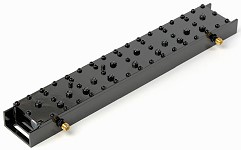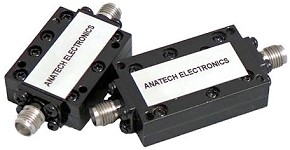|

Sam Benzacar, of RF and microwave filter company
Anatech
Electronics, has written as part of his March newsletter an article entitled,
"AESA Is Coming to the Cellular Industry," with the AESA being an Active Electronically-Scanned
Array. Sam keeps abreast of all the latest news in the wireless world, which is
not unexpected given his company's long-time involvement in helping others make
their products play well together in an increasingly crowded electromagnetic spectrum
- both licensed and unlicensed. Other news includes the FCC's licensing of the 95 GHz,
mm-wave band, Japan's first 8K (7680 × 4320-pixel) TV broadcasts, and Bluetooth
devices being powered from ambient energy - assuming it's inside in front of a transmitting
radar antenna ;-)
A Word from Sam Benzacar
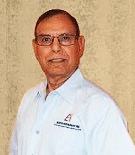 AESA Is
Coming to the Cellular Industry
By Sam Benzacar
It's pretty obvious to everyone who follows or is involved in the cellular industry
that achieving everything promised by 5G will require every bit of technological
wizardry that can be mustered, and the Active Electronically-Scanned Array (AESA)
architecture will be one the most important contributors. You won't find this acronym
in media coverage about 5G, as massive MIMO with "dozens of antennas" gets the attention.
Many readers of this column know AESA well, as it's the latest iteration of the
active phased array that makes possible the exceptional performance of next-generation
military radar and electronic warfare systems. There haven't been any commercial
uses of the AESA for several reasons, primarily that the relatively-low frequencies
currently used by the cellular industry don't require it, and that they would be
too large and expensive. However, as carriers hold their noses and use the millimeter-wave
spectrum, we'll all be hearing about AESA, or should be. At 28 GHz and 39 GHz and
above, this advanced technology provides enormous benefits, and the size of the
antenna is much smaller and potentially far less expensive.
At the moment, AESA radars cost millions of dollars because they're designed
for defense applications that require a massive array of capabilities as well as
the need to operate in fighter aircraft under hostile conditions. They're also produced
by the "military- industrial complex" rather than commercial and consumer products
manufacturers. Nevertheless, a millimeter-wave AESA would now still be prohibitively
expensive, but that may change as the cellular industry begins to face the realities
of delivering mobility at frequencies 10 times higher than today.
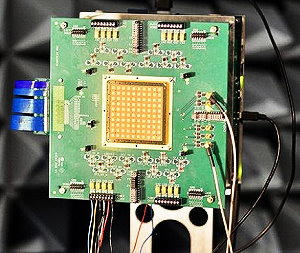
1. A 28-GHz phased array module developed by IBM Research and
Ericsson.
In fact, some companies already are. At least one (Anokiwave) has produced ICs
for 5G phased arrays such as the AWMF-0108 that supports four transmit and receive
antennas and includes gain control, phase shifters, beam steering, and other features
in a 6x6-mm QFM package. Other companies have been working to reduce the manufacturing
cost of AESA phased-array antennas for 5G.
MACOM, for example, has been collaborating with MIT's Lincoln Laboratory to realize
low-cost manufacturing techniques for massive MIMO and software-defined beamforming
for antenna systems with 64 T/R modules or more. The approach uses high-level functional
integration as well as commercial manufacturing processes and will require direct
RF sampling at the antenna port.
Direct RF sampling is currently being achieved in next-generation defense radars
and EW systems, all of which presumably operate at lower frequencies than the highest
ones conceived for 5G. These will require high-speed-sampling ADCs with high resolution
and dynamic range, which in addition to defense systems are used in millimeter-wave
test equipment, are extremely expensive, and are proprietary to their creators and
a smattering of defense contractors. A few of these ADCs can, according to what
can be gleaned from various sources, sample at 60 Gsamples/s and even higher performance
can be achieved when interleaving is used.
The task of reducing the cost of such systems is far from trivial but the benefits
for 5G are significant and will probably be mandatory for millimeter-wave applications
in which a hundred or more antennas and accompanying beamforming capabilities are
required to deliver truly massive MIMO. However, I suspect that by the time they're
needed, commercial-grade AESA architectures will have decreased in cost enough to
make them viable for cellular use, at least in some applications. If that proves
true, it will benefit not just the cellular industry but defense systems as well.
FCC Suggests Licensing 21 GHz of Bandwidth at 95 GHz
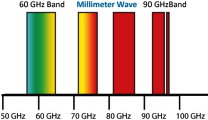 The FCC is considering a First Report and Order
that would adopt rules to make 21.2 GHz of spectrum above 95 GHz available for unlicensed
(and possibly licensed) operations. It would also create a new class of experimental
licenses for the 95 GHz to 3 THz spectrum range. The technology to achieve operation
at such frequencies is embryonic at best, which makes the FCC's attention to it
somewhat surprising at such an early stage. Applications considered for 95 GHz include
backhaul and point-to-point, and possibly mobility. The commission was supposed
to have addressed the use of these frequencies at a meeting on March 15 The FCC is considering a First Report and Order
that would adopt rules to make 21.2 GHz of spectrum above 95 GHz available for unlicensed
(and possibly licensed) operations. It would also create a new class of experimental
licenses for the 95 GHz to 3 THz spectrum range. The technology to achieve operation
at such frequencies is embryonic at best, which makes the FCC's attention to it
somewhat surprising at such an early stage. Applications considered for 95 GHz include
backhaul and point-to-point, and possibly mobility. The commission was supposed
to have addressed the use of these frequencies at a meeting on March 15
Xilinx, Samsung Develop 64 x 64 MIMO Solution
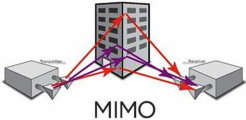 Xilinx and Samsung Electronics are working on
a 5G New Radio deployment in South Korea, the result of a collaboration of the two
companies to deploy 5G massive MIMO and millimeter-wave solutions using Xilinx's
UltraScale+ platform. Xilinx says it has a massive MIMO device with 64 transmitters
and 64 receivers and that it has created a way to bridge the digital and analog
domains to miniaturize the overall structure. Direct RF sampling is used to digitize
signals at very high frequencies and simultaneously process the signals on multiple
bands within its SoC. Xilinx and Samsung Electronics are working on
a 5G New Radio deployment in South Korea, the result of a collaboration of the two
companies to deploy 5G massive MIMO and millimeter-wave solutions using Xilinx's
UltraScale+ platform. Xilinx says it has a massive MIMO device with 64 transmitters
and 64 receivers and that it has created a way to bridge the digital and analog
domains to miniaturize the overall structure. Direct RF sampling is used to digitize
signals at very high frequencies and simultaneously process the signals on multiple
bands within its SoC.
NHK Delivers First 8K Broadcasts
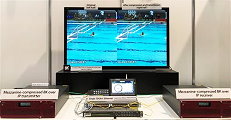 Japan's
NHK has initiated the world's first 8K broadcasting after more than 20 years of
development. A test color-bar pattern on the 8K TV screen was replaced at 10 a.m.
with new 8K (7680 × 4320-pixel) images along with immersive 22.2 multichannel sound.
The 8K channel, "NHK BS8K," is broadcast for about 12 hours daily. Programs include
entertainment, art, nature, and sports, and the 8K satellite broadcasts are delivered
in the ISDB-S3 transmission format with a transponder bandwidth of 34.5 MHz at 100 Mb/s. This provides for home delivery of one 8K channel or three 4K channels per
transponder. Japan's
NHK has initiated the world's first 8K broadcasting after more than 20 years of
development. A test color-bar pattern on the 8K TV screen was replaced at 10 a.m.
with new 8K (7680 × 4320-pixel) images along with immersive 22.2 multichannel sound.
The 8K channel, "NHK BS8K," is broadcast for about 12 hours daily. Programs include
entertainment, art, nature, and sports, and the 8K satellite broadcasts are delivered
in the ISDB-S3 transmission format with a transponder bandwidth of 34.5 MHz at 100 Mb/s. This provides for home delivery of one 8K channel or three 4K channels per
transponder.
Bluetooth Device Powered by Ambient RF Energy
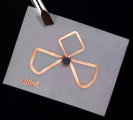 A new paper-thin, postage-stamp-size Bluetooth
chip has been designed that operates without a battery. The device, from start-up
Wiliot, can harvest energy from ambient RF energy from Wi-Fi, Bluetooth, and cellular
signals, and use them to power a Bluetooth-equipped ARM processor that can be connected
to a variety of sensors. Wiliot says that the size of the Bluetooth chip, combined
with the lack of any battery, means it can be produced cheaply and mounted on almost
anything. A new paper-thin, postage-stamp-size Bluetooth
chip has been designed that operates without a battery. The device, from start-up
Wiliot, can harvest energy from ambient RF energy from Wi-Fi, Bluetooth, and cellular
signals, and use them to power a Bluetooth-equipped ARM processor that can be connected
to a variety of sensors. Wiliot says that the size of the Bluetooth chip, combined
with the lack of any battery, means it can be produced cheaply and mounted on almost
anything.
Anatech Electronics Introduces a New Line of Suspended Stripline and
Waveguide Type RF Filters
Check out Our Filter Products
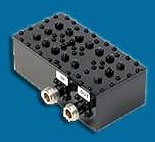
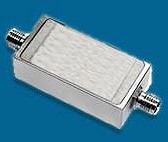

Cavity Band Pass Filters
LC Band Pass Filters Cavity Bandstop/Notch Filter
About Anatech Electronics
Anatech Electronics, Inc. (AEI) specializes in the design and manufacture of
standard and custom RF and microwave filters and other passive components and subsystems
employed in commercial, industrial, and aerospace and applications. Products are
available from an operating frequency range of 10 kHz to 30 GHz and include cavity,
ceramic, crystal, LC, and surface acoustic wave (SAW), as well as power combiners/dividers,
duplexers and diplexers, directional couplers, terminations, attenuators, circulators,
EMI filters, and lightning arrestors. The company's custom products and capabilities
are available at www.anatechelectronics.com.
Contact:
Anatech Electronics, Inc. 70 Outwater Lane Garfield, NJ 07026 (973)
772-4242
sales@anatechelectronics.com
Posted April 16, 2019
|












 The FCC is considering a First Report and Order
that would adopt rules to make 21.2 GHz of spectrum above 95 GHz available for unlicensed
(and possibly licensed) operations. It would also create a new class of experimental
licenses for the 95 GHz to 3 THz spectrum range. The technology to achieve operation
at such frequencies is embryonic at best, which makes the FCC's attention to it
somewhat surprising at such an early stage. Applications considered for 95 GHz include
backhaul and point-to-point, and possibly mobility. The commission was supposed
to have addressed the use of these frequencies at a meeting on March 15
The FCC is considering a First Report and Order
that would adopt rules to make 21.2 GHz of spectrum above 95 GHz available for unlicensed
(and possibly licensed) operations. It would also create a new class of experimental
licenses for the 95 GHz to 3 THz spectrum range. The technology to achieve operation
at such frequencies is embryonic at best, which makes the FCC's attention to it
somewhat surprising at such an early stage. Applications considered for 95 GHz include
backhaul and point-to-point, and possibly mobility. The commission was supposed
to have addressed the use of these frequencies at a meeting on March 15  Xilinx and Samsung Electronics are working on
a 5G New Radio deployment in South Korea, the result of a collaboration of the two
companies to deploy 5G massive MIMO and millimeter-wave solutions using Xilinx's
UltraScale+ platform. Xilinx says it has a massive MIMO device with 64 transmitters
and 64 receivers and that it has created a way to bridge the digital and analog
domains to miniaturize the overall structure. Direct RF sampling is used to digitize
signals at very high frequencies and simultaneously process the signals on multiple
bands within its SoC.
Xilinx and Samsung Electronics are working on
a 5G New Radio deployment in South Korea, the result of a collaboration of the two
companies to deploy 5G massive MIMO and millimeter-wave solutions using Xilinx's
UltraScale+ platform. Xilinx says it has a massive MIMO device with 64 transmitters
and 64 receivers and that it has created a way to bridge the digital and analog
domains to miniaturize the overall structure. Direct RF sampling is used to digitize
signals at very high frequencies and simultaneously process the signals on multiple
bands within its SoC.  Japan's
NHK has initiated the world's first 8K broadcasting after more than 20 years of
development. A test color-bar pattern on the 8K TV screen was replaced at 10 a.m.
with new 8K (7680 × 4320-pixel) images along with immersive 22.2 multichannel sound.
The 8K channel, "NHK BS8K," is broadcast for about 12 hours daily. Programs include
entertainment, art, nature, and sports, and the 8K satellite broadcasts are delivered
in the ISDB-S3 transmission format with a transponder bandwidth of 34.5 MHz at 100 Mb/s. This provides for home delivery of one 8K channel or three 4K channels per
transponder.
Japan's
NHK has initiated the world's first 8K broadcasting after more than 20 years of
development. A test color-bar pattern on the 8K TV screen was replaced at 10 a.m.
with new 8K (7680 × 4320-pixel) images along with immersive 22.2 multichannel sound.
The 8K channel, "NHK BS8K," is broadcast for about 12 hours daily. Programs include
entertainment, art, nature, and sports, and the 8K satellite broadcasts are delivered
in the ISDB-S3 transmission format with a transponder bandwidth of 34.5 MHz at 100 Mb/s. This provides for home delivery of one 8K channel or three 4K channels per
transponder.  A new paper-thin, postage-stamp-size Bluetooth
chip has been designed that operates without a battery. The device, from start-up
Wiliot, can harvest energy from ambient RF energy from Wi-Fi, Bluetooth, and cellular
signals, and use them to power a Bluetooth-equipped ARM processor that can be connected
to a variety of sensors. Wiliot says that the size of the Bluetooth chip, combined
with the lack of any battery, means it can be produced cheaply and mounted on almost
anything.
A new paper-thin, postage-stamp-size Bluetooth
chip has been designed that operates without a battery. The device, from start-up
Wiliot, can harvest energy from ambient RF energy from Wi-Fi, Bluetooth, and cellular
signals, and use them to power a Bluetooth-equipped ARM processor that can be connected
to a variety of sensors. Wiliot says that the size of the Bluetooth chip, combined
with the lack of any battery, means it can be produced cheaply and mounted on almost
anything. 